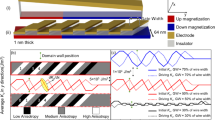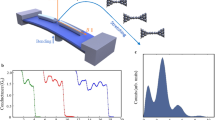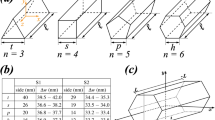Abstract
In some magnetic devices that have been proposed, the information is transmitted along a magnetic wire of submicrometre width by domain wall (DW) motion1,2. The speed of the device is obviously linked to the DW velocity, and measured values up to 1 km s−1 have been reported in moderate fields3. Although such velocities were already reached in orthoferrite crystal films with a high anisotropy4, the surprise came from their observation in the low-anisotropy permalloy. We have studied, by numerical simulation, the DW propagation in such samples, and observed a very counter-intuitive behaviour. For perfect samples (no edge roughness), the calculated velocity increased with field up to a threshold, beyond which it abruptly decreased — a well-known phenomenon5. However, for rough strip edges, the velocity breakdown was found to be suppressed. We explain this phenomenon, and propose that roughness should rather be engineered than avoided when fabricating nanostructures for DW propagation.
This is a preview of subscription content, access via your institution
Access options
Subscribe to this journal
Receive 12 print issues and online access
$259.00 per year
only $21.58 per issue
Buy this article
- Purchase on Springer Link
- Instant access to full article PDF
Prices may be subject to local taxes which are calculated during checkout



Similar content being viewed by others
References
Allwood, D.A. et al. Submicrometer ferromagnetic NOT gate and shift register. Science 296, 2003–2006 ( 2002).
Shiratori, T., Fujii, E., Miyaoka, Y. & Hozumi, Y. High-density magneto-optical recording with domain wall displacement detection. J. Magn. Soc. Jpn 22-S2, 47–50 ( 1998).
Atkinson, D. et al. Magnetic domain wall dynamics in a submicrometre ferromagnetic structure. Nature Mater. 2, 85–87 ( 2003).
Malozemoff, A.P. & Slonczewski, J.C. Magnetic Domain Walls in Bubble Materials (Academic, New York, 1979).
Schryer, N.L. & Walker, L.R. The motion of 180° domain walls in uniform dc magnetic fields. J. Appl. Phys. 45, 5406–5421 ( 1974).
Thiaville, A., Garcia, J.M. & Miltat, J. Domain wall dynamics in nanowires. J. Magn. Magn. Mater. 242–245, 1061–1063 ( 2002).
Nakatani, Y., Hayashi, N., Ono, T. & Miyajima, H. Computer simulation of domain wall motion in a magnetic strip line with submicron width. IEEE Trans. Magn. 37, 2129–2131 ( 2001).
McMichael, R.D. & Donahue, M.J. Head to head domain wall structures in thin magnetic strips. IEEE Trans. Magn. 33, 4167–4169 ( 1997).
Hubert, A. & Schäfer, R. Magnetic domains (Springer, Berlin, 1998).
Thiele, A. Steady-state motion of magnetic domains. Phys. Rev. Lett. 30, 230–233 ( 1973).
Feldtkeller, E. Mikromagnetisch stetige und unstetige Magnetisierungskonfigurationen. Z. Angew. Phys. 19, 530–536 ( 1965).
Thiele, A.A. & Asselin, P. Model for dynamic domain wall coercivity. J. Appl. Phys. 55, 2584–2586 ( 1984).
Bouzidi, D. & Suhl, H. Motion of a Bloch domain wall. Phys. Rev. Lett. 65, 2587–2590 ( 1990).
Schrefl, T., Fidler, J., Kirk, K.J. & Chapman, J.N. Simulation of magnetization reversal in polycrystalline patterned Co elements. J. Appl. Phys. 85, 6169–6171 ( 1999).
Hadjipanayis, G.C. Nanophase hard magnets. J. Magn. Magn. Mater. 200, 373–391 ( 2000).
Ono, T. et al. Propagation of a magnetic domain wall in a submicrometer magnetic wire. Science 284, 468–470 ( 1999).
Gadbois, J. & Zhu, J.-G. Effect of edge roughness in nano-scale magnetic bar switching. IEEE Trans. Magn. 31, 3802–3804 ( 1995).
Cowburn, R.P., Koltsov, D.K., Adeyeye, A.O. & Welland M.E. Lateral interface anisotropy in nanomagnets. J. Appl. Phys. 87, 7067–7069 ( 2000).
Nakatani, Y., Uesaka, Y. & Hayashi, N. Direct solution of the Landau-Lifshitz-Gilbert equation for micromagnetics. Jpn J. Appl. Phys. 28, 2485–2507 ( 1989).
Fukushima, H., Nakatani, Y. & Hayashi, N. Volume average demagnetizing tensor of rectangular prisms. IEEE Trans. Magn. 34, 193–198 ( 1998).
Hayashi, N., Saito, K. & Nakatani, Y. Calculation of demagnetizing field distribution based on fast Fourier transform of convolution. Jpn J. Appl. Phys. 35, 6065–6073 ( 1996).
Donahue, M.J. & Porter, D.G. OOMMF User's Guide, Version 1.0. Interagency Report NISTIR 6376 (National Institute of Standards and Technology, Gaithersburg, 1999).
Press, W.H., Teukolsky, S.A., Vetterling, W.T. & Flannery, B.P. Numerical Recipes in FORTRAN (Cambridge Univ. Press, New York, 1992).
Acknowledgements
We thank D. Atkinson, G. Xiong and R. P. Cowburn for communicating their results before publication of Ref. 3. The stay of Y.N. at Orsay was supported by a grant from the Ministry of Education, Culture, Sports, Science and Technology of Japan.
Author information
Authors and Affiliations
Corresponding author
Ethics declarations
Competing interests
The authors declare no competing financial interests.
Rights and permissions
About this article
Cite this article
Nakatani, Y., Thiaville, A. & Miltat, J. Faster magnetic walls in rough wires. Nature Mater 2, 521–523 (2003). https://doi.org/10.1038/nmat931
Received:
Accepted:
Published:
Issue Date:
DOI: https://doi.org/10.1038/nmat931
This article is cited by
-
Creation of transverse domain walls in permalloy nanowires using Lorentz transmission electron microscopy: progress, opportunities, and challenges
Journal of the Korean Physical Society (2023)
-
Skyrmion motion and partitioning of domain wall velocity driven by repulsive interactions
Communications Physics (2022)
-
Relativistic domain-wall dynamics in van der Waals antiferromagnet MnPS3
npj Computational Materials (2022)
-
Magnetodynamic properties on square patterned of FeGaB and Al2O3/FeGaB thin films
Journal of Materials Science: Materials in Electronics (2022)
-
Determination of the Dzyaloshinskii-Moriya interaction using pattern recognition and machine learning
npj Computational Materials (2021)



